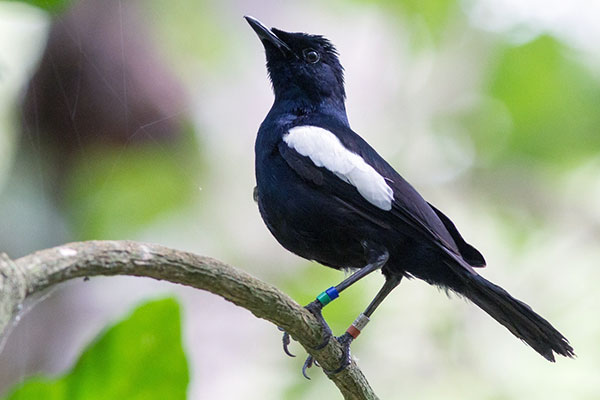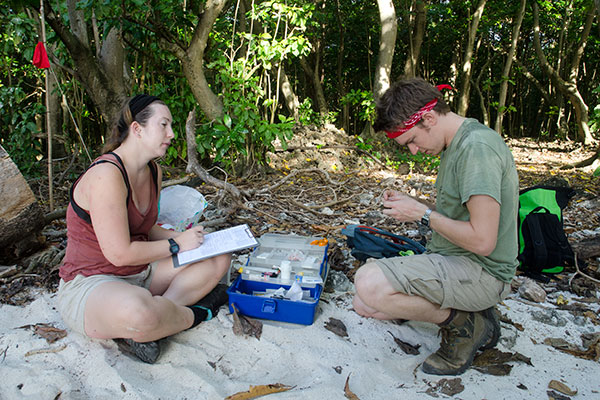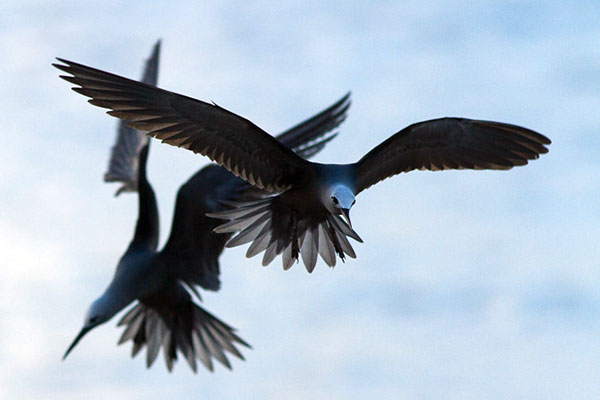Monitoring and research overview
In line with Nature Seychelles mission to improve the conservation of biodiversity through science, management, education and training, the conservation programme on Cousin involves research, monitoring and management of threatened endemic wildlife and their habitats.

Seychelles Magpie Robin
This charismatic bird, originally found in great numbers on several islands, was in 1990 down to a population of only 23 birds on Frégate Island, making it one of the most critically endangered species in the world. A special recovery program was established leading to the eventual translocation of several birds to Cousin, Cousine, Aride and Denis islands. Today, the Cousin Island population is between 45-50. Nature Seychelles coordinates the Seychelles Magpie Robin Recovery Team (SMART), which ensures the continuous monitoring and conservation management of these birds. Every 6 months a meeting is held to share news and data from each island and make necessary conservation management decisions. On Cousin the birds are monitored to keep continuous records of their behaviour and breeding biology.

This little bird is the main reason why Cousin became a nature reserve. Working in conjunction with Nature Seychelles, research is carried out by the Seychelles Warbler Group led by Profs. David Richardson (University of East Anglia, UK), Jan Komdeur (University of Groningen, the Netherlands), Terry Burke (University of Sheffield, UK) and Dr Hannah Dugdale (University of Leeds). Each year a team of PhD researchers come to Cousin from these universities to continue the research and monitoring of the Seychelles warbler. For more information visit Seychelles Warbler Research Group page on Nature Seychelles’ website.

Cousin is an important breeding area for the White tern, White-tailed Tropicbird, Brown & Lesser Noddys, Bridled Terns, Tropical Shearwaters and Wedge-tailed Shearwaters. Some birds are year-round breeders, others have particular breeding seasons. All of these birds are a critical part of the oceans food web and can be used as bio-indicators of changes in the oceans. Likewise on land their guano creates a nutrient enriched soil which supports a wealth of plans, trees and shrubs who in their turn support a large abundance of insects providing food for the reptiles and land birds of the island. Throughout the year seabird population censuses and monitoring are carried out in order to gain a long-term data set allowing for trends to be discovered. Nature Seychelles is also the founder of the Seychelles Seabird Group (SSG), which combines all the important seabird nesting islands. The SSG meets every six months to share data, information and to act as a troubleshooting arena for seabird conservation managers.

Coral Reef and Marine Monitoring
As one of the longest established no-take marine reserves in the world Cousin Island provides a unique study site for the effects of protection on coral reef ecosystems. The coral reefs surrounding Cousin have undergone many changes over the past decade; they were particularly badly affected by the global coral bleaching event of 1998 which led to a reduction in live coral cover and a resultant increase in algal cover. Over the years there has been marine mapping projects and yearly monitoring to gauge abundance of fish, coral cover, invertebrates and coral recruits. Monitoring takes place in April and October. The MPA is also home to the world’s firs coral reef restoration project.

